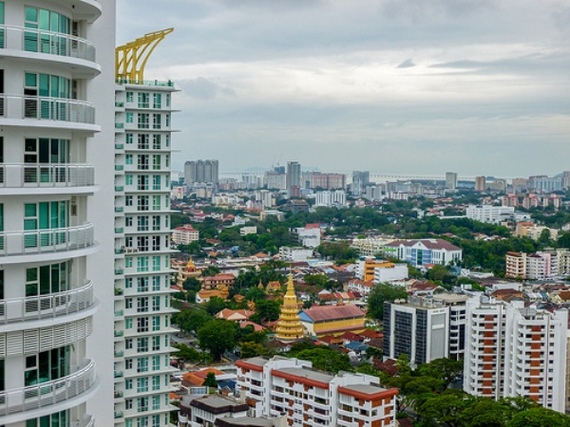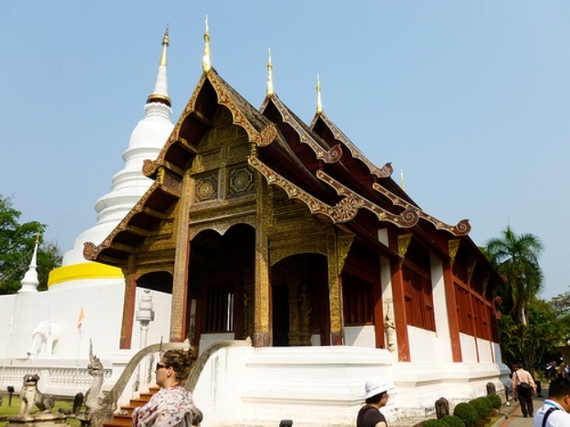By Steenie Harvey, InternationalLiving.com
This article comes to us courtesy of InternationalLiving.com, the world's leading authority on how to live, work, invest, travel, and retire better overseas.
Night markets, floating markets, jade and pearl markets. Wet markets with fish you never imagined existed. Stalls selling ants' eggs. Tuk-tuks, cyclo-rickshaws, and longboat journeys through the jungle. The impossibly brilliant green of rice paddy fields. Seas that shimmer like a peacock's feathers.
Photo: InternationalLiving.com
Saffron-robed monks. Spirit houses. Orangutans. Elephant rides. Butterflies bigger than your fist...
Southeast Asia is adventure travel at its most exotic. Each day brings new sights, smells, tastes, and experiences. Cultural encounters, too. The Bangkok taxi driver who asked to borrow my glasses (he thought they'd help his eyesight)...the former head-hunters of the Iban tribe who still live in traditional longhouses in Borneo...the sing-along with locals in a Filipino karaoke bar.
And if you're drawn to oddities, you'll never be disappointed. For example, watching fish in a feeding frenzy is always mesmerizing. And it's especially mesmerizing when the fish food happens to be your flesh. For around $7, I tried a "fish pedicure" in Malaysia, but many salons across Southeast Asia offer the same. Shoals of Garra rufa fish--tiny carp that are thankfully toothless--gorge away on the dead skin on your feet for around 30 or 40 minutes. Initially it's an appalling sensation, but it leaves feet feeling almost brand-new.
Hell and Horror in Thailand
When it comes to bizarrities, Thailand is an absolute treasure trove. If you've ever wondered what a Buddhist hell garden contains, visit Wat Pa Lak Roy. Not far from the city of Nakhon Ratchasima, in the country's Northeastern Isaan province, this grotesque theme park of torments has sculptures that seem designed to put anyone off fleshly pleasures and indulgences forever.
Photo: InternationalLiving.com
Gory images of sex and death are wherever you turn -- and most sculptures can be animated into screams by putting a coin in a slot. For adults only? Not at all. Watching dogs biting off a man's pride and joy and women getting ripped apart by giant frogs qualifies as a fun day out for many Thai families, even those with young children.
If pickled body parts don't upset you, the Medical Museum inside Bangkok's Siriraj Hospital is the ultimate horror show. It's nicknamed the Museum of Death, and the exhibits of all the ghastly ways to shuffle off this mortal coil leave nothing to the imagination. Its prize offering is the embalmed corpse of a cannibal serial killer executed in the late 1950s. (Forensic Medicine Building, Siriraj Hospital.)
Walk on the Culinary Wild Side
Few westerners wake up thinking, "Mmm... I just fancy a bowl of frog porridge." I certainly never have. But if you do, the dish is easily found in Singapore, Malaysia, and most places with a Chinese community.
You can't say you don't like bugs unless you've sampled them. If you don't think too hard about what's going into your mouth, bamboo worms make for an interesting beer snack. In Thailand, they're fried to crispiness and are far more nutritious than a bag of chips.
For the best of Southeast Asia on a plate, I'd choose the Malaysian island of Penang. Especially Georgetown, the island's capital -- you'll eat wondrously well even on a minimal budget. Home to large Chinese and Indian communities as well as native Malaysians, this old colonial city is a glutton's delight.
Take breakfast. You could opt for dim sum in Chinatown, mild vegetable or fish-head curry (I love it) with roti canai flat bread in Little India, or nasi lemak everywhere. Nasi lemak is a Malaysian breakfast specialty, usually served in a banana-leaf packet -- coconut-flavored rice with chopped hard-boiled egg, small fried anchovies, and sometimes spicy chicken, too. Also try bak-kut-teh: a herby pork broth spiked with bean curd and mushrooms.
If things start getting too gastronomically tame, follow your nose to a fruit stall. Although they taste deliciously custardy, durian fruits are supremely odiferous -- the smell is like a cross between rutting goats and a baby's filled diaper. Durians grow all over Southeast Asia, and they could be described as "forbidden fruit." Due to the obnoxious smell, they're banned in most hotels, as well as on public transport.
Temple Offerings
Southeast Asia abounds in architecturally stunning temples. Thailand's Buddhist temples (wats) are especially outstanding, but if you only have time to visit one in Bangkok, make it Wat Pho. It houses a gigantic reclining Buddha. The city of Chiang Mai, in northern Thailand, is perhaps best known for its huge night market, but it also has over 200 Buddhist wats. Many are hundreds of years old and flamboyantly decorated, with Naga serpent staircases and temple guardians in the shape of dragons and Singha lions.
With its pit vipers and green tree-snakes hanging from wherever they fancy, the Taoist Snake Temple on Penang (Malaysia) qualifies as an oddity. Although it's rumored the snakes are kept doped, it isn't for those with a phobia. But for overall weirdness, the Cao Dai temple, at Tay Ninh in Vietnam, is hard to beat. And it's not only because of the technicolor kitsch of its dragon-wrapped columns and all-seeing divine eyes.
Originating in Vietnam in the 1920s, Cao Dai is an eclectic fusion of beliefs. Its followers have some seriously strange spirit guides: Lenin, Shakespeare, Joan of Arc, and Napoleon Bonaparte, to name a few. The French writer Victor Hugo is worshipped as a saint. Cao Dai priests wear vivid blue, red, and yellow robes, and the congregation dresses in white.
Day-trips out of Ho Chi Minh City (formerly Saigon) arrive for the noon service, and usually carry on to the Cu Chi tunnels -- an underground network used to great effect by the Vietcong during the Vietnam War.
Fearsome Festivities
Thaipusam is the strangest festival I've ever witnessed. It's a Hindu celebration marked by Tamil communities all across Asia. Depending on the lunar calendar, it takes place at the end of January or early February. Men pierce their bodies and cheeks with metal skewers -- some have tiny milk jugs attached to their chests. Decorated carts are pulled by means of hooks embedded in men's backs. It looks excruciatingly painful.
Outside India, some of the largest commemorations are in Malaysia. I followed the Thaipusam procession in Kuching on the island of Borneo. You're more likely to get close up to the procession here than in Kuala Lumpur, Malaysia's capital. There, Thaipusam attracts over 250,000 devotees streaming out of the city to a temple at the Batu Caves.
Related Articles:
Break Free from the Office and Discover the World
The 5 Best Places for Expats to Live in Thailand
Thailand, Cambodia and Malaysia: Three Great Destinations to Live in Southeast Asia
Earlier on Huff/Post50:



